How to cook the perfect toad in the hole
Is toad in the hole a school-dinner classic or a waste of good sausages?
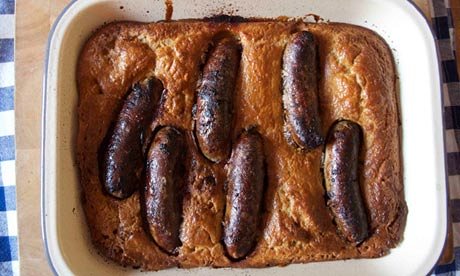
Felicity's perfect toad in the hole. Photograph: Felicity Cloake
"A homely and savoury dish" according to Mrs Beeton, toad in the hole was originally made with any old meat that came to hand – the original domestic goddess suggests rump steak and lamb's kidney, while a reference a century earlier glosses it as "baked beef in a pudding" and Hannah Glasse gives a recipe for pigeons in a hole.
Charles Francatelli's Plain Cookery Book for the Working Classes (1852), meanwhile, is frank about the main attraction of the toad – its price. "To make this a cheap dinner, you should buy 6d. or 1s. worth of bits or pieces of any kind of meat, which are to be had cheapest at night when the day's sale is over. The pieces of meat should be first carefully overlooked, to ascertain if there be any necessity to pare away some tainted part, or perhaps a fly-blow, as this, if left on any one piece of meat, would tend to impart a bad taste to the whole, and spoil the dish" he writes, temptingly.
Clearly toad in the hole (a phrase that tellingly makes its way into the 1811 Dictionary of the Vulgar Tongue), was a way of stretching meat – any meat – a bit further, with a filling and thrifty batter. It does the same for its modern-day incarnation: you can get away with serving one sausage each if you've got enough batter and a good gravy. But, whether you're on a tight budget or not, toad in the hole is no croak of a dish: enjoy it, warts and all.
The toad
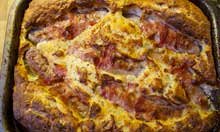
Nigel Slater's toad in the hole. Photograph: Felicity Cloake
There are several modern recipes that draw on the more ancient tradition of the toad in the hole: Hugh Fearnley-Whittingstall's River Cottage Meat Book suggests a "flying toad in the hole" with pheasant breasts and prunes, while the Ginger Pig Meat Book stuffs the sausages into pieces of chicken. Although in a straight fight pheasant would clearly win, choosing between different meats seems a rather silly exercise in this context, so I'm going to stick to a sausage-only toad.
After trying almost every variety under the sun, those sausages should, I think, be pretty plain affairs – tasting mostly of pork rather than leek, apple or (shudder) chilli – anything too strident makes the batter seem unfairly bland by comparison. That said, the more mildly spiced British sausages, a herby Lincolnshire, or a peppery Cumberland, can also work well.
My devotion to Nigel Slater prompts my one deviation from the sausage-only path; he wraps his sausages in pancetta, like posh pigs in blankets, before baking. It's rare for me to veto cured pork, but here I'm not keen: the fat from the pancetta melts during cooking, so the sausages seem to stew in it rather than browning, and the whole thing tastes overwhelmingly of bacon.
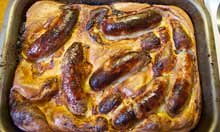
Delia Smith's toad in the hole. Photograph: Felicity Cloake
As in the recipe in Simon Hopkinson and Lindsey Bareham's nostalgia-fest The Prawn Cocktail Years, Nigel skins his sausages before baking. Nigella also does this, complaining that "I really don't like the way that the sausages, when this is prepared in the traditional manner, go a spooky braised pink as they cook within the batter".
I'm also a bit squeamish about pallid bangers, but baked skinless sausages end up dry – much better to do as Smith, Dorothy Hartley, Paul Gayler and Jane Grigson do, and pre-cook the sausages before adding them to the batter. Brown them well and there's no danger of flabby disappointment: frying, as Mrs Grigson suggests, works better than Smith and Gayler's baking – it's easier to turn them, they stay juicier and you can use the delicious sausage-flavoured cooking fat to grease the baking tin.
Better batter
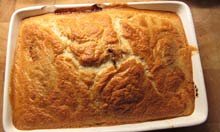
Dorothy Hartley's toad in the hole. Photograph: Felicity Cloake
A good sausage is always a treat but tasty batter takes a little more work. I experiment with milk (Grigson), milk and water (Slater and Smith), milk and sparkling water (Simon Hopkinson and Lindsey Bareham) and milk and pale ale (Gayler). The all-milk pudding is definitely richer, but also noticeably softer and doughier. Water gives a crisper result, and sparkling water, as the authors note, an even lighter batter – but the flavour isn't as good. Using a mildly sparkling beer instead means the batter is both light and tasty, and handily leaves you with most of a bottle to enjoy while the toad cooks.
I don't find Smith allows enough batter for the number of sausages: it's too thin and, although it does rise, it doesn't put on the spectacular display of Grigson or the Prawn Cocktail Years' puddings. Nothing can match the batter from Hartley's Food in England though, which adapts a batter pudding recipe for toad in the hole, and whisks the egg whites to stiff peaks before folding them in. This rises over the sausages, completely encasing them, and creating something more akin to a toad cake – unusual, certainly, but not quite what my testers were hoping for when I promised them toad in the hole.
More successful is the Prawn Cocktail Years batter, which is deemed to boast the perfect balance of crisp top and soft, slightly gooey interior. I suspect this is partly down to the prolonged beating of the eggs, which gives the batter real volume.
Like most other recipes, save for Smith's, the batter is left to rest for 15 minutes before use, which the Leith's Meat Bible helpfully explains allows the starch cells in the flour to swell, which apparently makes for a lighter end product. Smith says she's never found that it makes a difference, but as far as I'm concerned, the results speak for themselves: the toad don't lie.
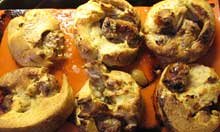
Paul Gayler's toad in the hole. Photograph: Felicity Cloake
Getting the pan nice and hot, as almost everyone suggests, is essential for a crispy base – the fat (I like dripping or lard; Smith's groundnut oil is deliberately bland, and Gayler's olive oil all wrong here) should be smoking, and the batter must sizzle as it hits it. Grigson coats the base of the tin with a thin layer of batter and bakes for 10 minutes "to set" before adding the remainder, along with the sausages, but I don't find it makes much of a difference. Batter first, sausages immediately afterwards seems to work best: sausage first, a la Delia, means the toad has a leaky bottom.
Gayler makes individual toad in the holes in a muffin tin. They look cute – and one of my testers argues passionately that they ensure a more equitable ratio of batter to sausage – but I find them soggy in the middle: there's just not enough room for both the batter and the sausage to live in peace.
Extras
Simon and Lindsey coat their sausages in ketchup and add sage leaves to their batter, both of which I find overpowering. A much happier a match, in my opinion, is Nigel Slater's wholegrain mustard, which studs the toad with crunchy seeds and lends a welcome heat to proceedings. That's about as fancy as Mr Toad should get.
Perfect toad in the hole
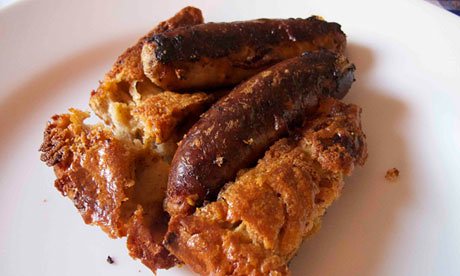
Felicity Cloake's perfect toad in the hole. Photograph: Felicity Cloake
Serves 2–4 depending on appetite
- 3tbsp beef dripping or lard
- 6 sausages
- 2 eggs
- 100g plain flour, sifted
- 85ml whole milk
- 85ml ale
1. Preheat the oven to 220C. Heat half the fat in a frying pan over a medium heat and brown the sausages on all sides (this is labour-intensive but worth it).
2. Meanwhile put the eggs in a large bowl and beat, preferably with an electric hand whisk, until thick. Beat in the flour and milk alternately until smooth, then stir in the ale and mustard and leave to sit for 15 minutes.
3. Put the remaining fat in a roasting tin (mine's about 26cm x 21cm) and put in the oven to heat. Once the sausages are browned all over, and the batter has rested, take it out of the oven and put over a medium flame. Pour in the fat from the sausage pan, followed by the batter, which should sizzle as it hits the tin. Add the sausages and return to the oven.
4. Bake for about 35 minutes until well risen and golden, then serve immediately, preferably with good gravy and lots of peas.
Toad in the hole: a school-dinner classic, or a waste of good sausages? Is there a better batter pudding out there, and, most importantly of course, does anyone know how on earth it got its name?